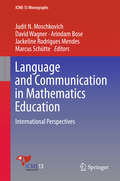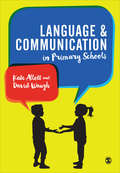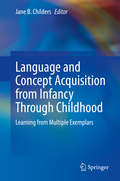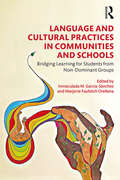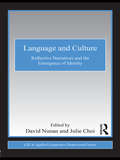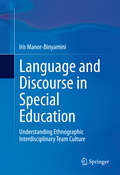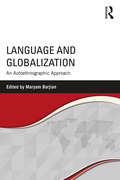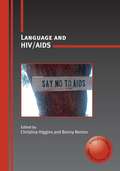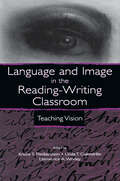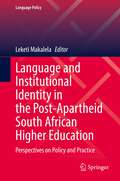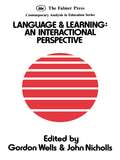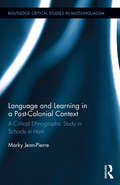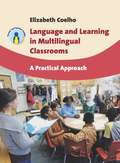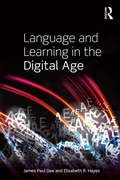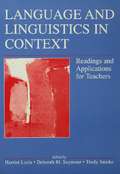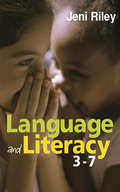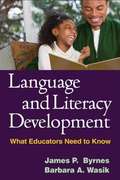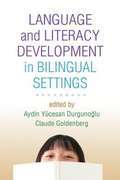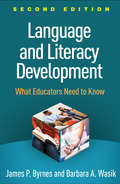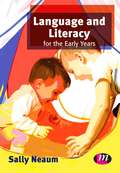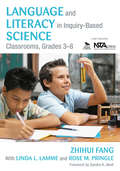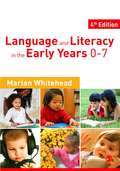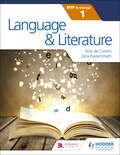- Table View
- List View
Language and Communication in Mathematics Education: International Perspectives (ICME-13 Monographs)
by Judit N. Moschkovich David Wagner Arindam Bose Jackeline Rodrigues Mendes Marcus SchütteThis book considers some of the outstanding questions regarding language and communication in the teaching and learning of mathematics – an established theme in mathematics education research, which is growing in prominence. Recent research has demonstrated the wide range of theoretical and methodological resources that can contribute to this area of study, including those drawing on cross-disciplinary perspectives influenced by, among others, sociology, psychology, linguistics, and semiotics. Examining language in its broadest sense to include all modes of communication, including visual and gestural as well as spoken and written modes, it features work presented and discussed in the Language and Communication topic study group (TSG 31) at the 13th International Congress on Mathematical Education (ICME-13). A joint session with participants of the Mathematics Education in a Multilingual and Multicultural Environment topic study group (TSG 32) enhanced discussions, which are incorporated in elaborations included in this book. Discussing cross-cutting topics it appeals to readers from a wide range of disciplines, such as mathematics education and research methods in education, multilingualism, applied linguistics and beyond.
Language and Communication in Primary Schools
by Kate Allott David WaughLanguage and communication are essential in the classroom: essential in children’s learning, essential in teachers’ communication with children, and essential in children’s understanding of themselves and their world. This book is a guide for trainee and beginning teachers on how to support and develop talk in the classroom. It explores the theory behind the teaching of language and communication skills and includes lots of practical advice on how to translate this into the classroom. It tackles the challenges and issues of managing talk in the classroom setting, and explores the role of language in children’s learning. The book addresses the challenge of language difficulties and delayed language development among children entering school. The crucial role of adults in supporting early language development is explained, and the book also considers the needs of children for whom English is an additional language.
Language and Communication in Primary Schools
by David Waugh Kate AllottLanguage and communication are essential in the classroom: essential in children's learning, essential in teachers' communication with children, and essential in children's understanding of themselves and their world. This book is a guide for trainee and beginning teachers on how to support and develop talk in the classroom. It explores the theory behind the teaching of language and communication skills and includes lots of practical advice on how to translate this into the classroom. It tackles the challenges and issues of managing talk in the classroom setting, and explores the role of language in children's learning. The book addresses the challenge of language difficulties and delayed language development among children entering school. The crucial role of adults in supporting early language development is explained, and the book also considers the needs of children for whom English is an additional language.
Language and Concept Acquisition from Infancy Through Childhood: Learning from Multiple Exemplars
by Jane B. ChildersThis book examines the role of experience-based learning on children’s acquisition of language and concepts. It reviews, compares, and contrasts accounts of how the opportunity to recognize and generalize patterns influences learning. The book offers the first systematic integration of three highly influential research traditions in the domains of language and concept acquisition: Statistical Learning, Structural Alignment, and the Bayesian learning perspective. Chapters examine the parameters that constrain learning, address conditions that optimize learning, and offer explanations for cases in which implicit exemplar-based learning fails to occur. By exploring both the benefits and challenges children face as they learn from multiple examples, the book offers insight on how to better able to understand children’s early unsupervised learning about language and concepts. Topics featured in this book include:Competing models of statistical learning and how learning might be constrained by infants’ developing cognitive abilities.How experience with multiple exemplars helps infants understand space and other relations.The emergence of category-based inductive reasoning during infancy and early childhood.How children learn individual verbs and the verb system over time. How statistical learning leads to aggregation and abstraction in word learning.Mechanisms for evaluating others’ reliability as sources of knowledge when learning new words.The Search for Invariance (SI) hypothesis and its role in facilitating causal learning. Language and Concept Acquisition from Infancy Through Childhood is an essential resource for researchers, clinicians and related professionals, and graduate students in infancy and early child development, applied linguistics, language education, child, school, and developmental psychology and related mental health and education services.
Language and Cultural Practices in Communities and Schools: Bridging Learning for Students from Non-Dominant Groups
by Inmaculada M. García-Sánchez Marjorie Faulstich OrellanaDrawing on sociocultural theories of learning, this book examines how the everyday language practices and cultural funds of knowledge of youth from non-dominant or minoritized groups can be used as centerpoints for classroom learning in ways that help all students both to sustain and expand their cultural and linguistic repertoires while developing skills that are valued in formal schooling. Bringing together a group of ethnographically grounded scholars working in diverse local contexts, this volume identifies how these language practices and cultural funds of knowledge can be used as generative points of continuity and productively expanded on in schools for successful and inclusive learning. Ideal for students and researchers in teaching, learning, language education, literacy, and multicultural education, as well as teachers at all stages of their career, this book contributes to research on culturally and linguistically sustaining practices by offering original teaching methods and a range of ways of connecting cultural competencies to learning across subject matters and disciplines.
Language and Culture: Reflective Narratives and the Emergence of Identity (ESL & Applied Linguistics Professional Series)
by David NunanThis state-of-the-art exploration of language, culture, and identity is orchestrated through prominent scholars’ and teachers’ narratives, each weaving together three elements: a personal account based on one or more memorable or critical incidents that occurred in the course of learning or using a second or foreign language; an interpretation of the incidents highlighting their impact in terms of culture, identity, and language; the connections between the experiences and observations of the author and existing literature on language, culture and identity. What makes this book stand out is the way in which authors meld traditional ‘academic’ approaches to inquiry with their own personalized voices. This opens a window on different ways of viewing and doing research in Applied Linguistics and TESOL. What gives the book its power is the compelling nature of the narratives themselves. Telling stories is a fundamental way of representing and making sense of the human condition. These stories unpack, in an accessible but rigorous fashion, complex socio-cultural constructs of culture, identity, the self and other, and reflexivity, and offer a way into these constructs for teachers, teachers in preparation and neophyte researchers. Contributors from around the world give the book broad and international appeal.
Language and Discourse in Special Education
by Iris Manor-BinyaminiThis book examines the words and discourse as well as their meaning and impact on the everyday culture of a multidisciplinary team at a school for students with mental disabilities. The book examines the organizational, social, professional, and emotional experiences of team members from such disciplines as child and school psychology, special education, therapy (e. g. , occupational, speech), social work, and pediatric medicine within a special education school. It explores the ways in which team members describe and interpret the day-to-day requirements of working effectively in a special education school, using their own language and discourse from a subjective point of view. In addition, the book analyzes and interprets the influence of language and discourse on the outlook, behavior patterns, and the coping of team members working in the school with the students, among themselves as a team, and with the difficulties and dilemmas that concern them as well the solutions that they themselves introduce for all these issues. This book, with its focus on the unique and complex work environment of the multidisciplinary special education team, is essential reading for researchers, professionals, and graduate students in child and school psychology, therapeutic disciplines (e. g. , occupational, speech), social work, pediatric medicine, and allied mental health and medical fields.
Language and Globalization: An Autoethnographic Approach
by Maryam BorjianIn this collection of real-life, personal narratives on the theme of language and globalization, scholars from a range of different sub-disciplines of linguistics, time periods, and geographical spaces throughout the world examine the interaction and intersectionality of languages and globalization and the implications of such interactions for world languages and cultures. A feature of the book is the application of autoethnography as its underlying approach/method, in which contributors draw on their own lived experiences (of life, scholarship, and work) to investigate and reflect on linguistic globalization and its issues and challenges against the backdrop of the globalized world of the 21st century.
Language and HIV/AIDS
by Bonny Norton Christina HigginsThis volume focuses on the role of language in the construction of knowledge about HIV/AIDS in diverse regions of the world. The collection of studies yields helpful insights about the discursive construction of this knowledge in both formal and informal contexts, while demonstrating how the tools of applied linguistics can be exercised to reveal a deeper understanding of the production and dissemination of this knowledge. The authors use a range of qualitative methodologies to critically explore the role of language and discourse in educational contexts in which various and sometimes competing forms of knowledge about HIV/AIDS are constructed. They draw on various forms of discourse analysis, ethnography, and social semiotics to interpret meaning-making practices in HIV/AIDS education in Australia, Cambodia, Burkina Faso, Hong Kong, India, South Africa, Tanzania, Thailand, and Uganda.
Language and Image in the Reading-Writing Classroom: Teaching Vision
by Kristie S. Fleckenstein Linda T. Calendrillo Demetrice A. WorleyThis volume offers concrete answers to the question of how we can use imagery to enrich the teaching of reading and writing. The chapters are organized according to two guiding principles. First, each addresses specific aspects of the inextricable integration of imagery and language in the teaching of reading and writing. Imagery is not privileged over language; the fusion of the two is emphasized. Second, each focuses on a particular kind of imagery--mental, graphic, or verbal--describing teaching/learning strategies based on the deployment of that kind of imagery in the classroom. There is currently a renewed acknowledgment of the importance of imagery in meaning. The rapid spread of the World Wide Web, computer interfacing, and virtual reality further highlights the need to attend to the influence of imagery in a networked world. In response to these shifts in scholarly and cultural perspectives, NCTE has established a committee on visual literacy, and an emphasis on visual literacy has been incorporated into the IRA/NCTE Standards for the English Language Arts. This book contributes significantly toward filling the need for explicit and specific theory-based methods teachers can use to integrate imagery into their pedagogy. Accessible and lively chapters include classroom activities and student-generated examples. Language and Image in the Reading-Writing Classroom is an excellent text for preservice and in-service pedagogy courses and an important resource for practicing teachers, researchers, and professionals in the field.
Language and Institutional Identity in the Post-Apartheid South African Higher Education: Perspectives on Policy and Practice (Language Policy #27)
by Leketi MakalelaThis book examines the intersections between education, identity formation, and language in post-apartheid South Africa with specific attention to higher education. It does so against the backdrop of the core argument that the sector plays a critical role in shaping, (re)producing and perpetuating sectoral, class, sub-national and national identities, which in turn, in the peculiar South African setting, are almost invariably analogous with the historical fault lines determined and dictated by language as a marker of ethnic and racial identity. The chapters in the book grapple with the nuances related to these intersections in the understanding that higher education language policies – overt and/or covert – largely structure institutional cultures, or what has been described as curriculum in higher education institutions. Together, the chapters examine the roles played by higher education, by language policies, and by the intersections of these policies and ethnolinguistic identities in either constructing and perpetuating, or deconstructing ethnolinguistic identities upon which the sector was founded. The introductory chapter lays out the background to the entire book with an emphasis on the policy and practice perspectives on the intersections. The middle chapters describe the so-called “White Universities”, “Black Universities” and “Middle-Man Minorities Universities”. The final chapter maps out future directions of the discourses on language and identity formation in South Africa’s higher education.
Language And Learning: An Interactional Perspective
by John NichollsFirst published in 1985. Routledge is an imprint of Taylor & Francis, an informa company.
Language and Learning in a Post-Colonial Context: A Critical Ethnographic Study in Schools in Haiti (Routledge Critical Studies in Multilingualism)
by Marky Jean-PierreThis book explores the social, political, and historical forces that mediate language ideology and practices in post-colonial education and how such ideology and practices influence students’ academic achievement. Jean-Pierre provides empirical evidence that a relationship exists between language practices and school underperformance. He takes Haiti as the focus of study, finding that students and teachers experience difficulty constructing knowledge in a setting in which the language they speak at home (Creole) differs from the language of instruction (French). The research is based on ethnographic data collected in classrooms in both private and public school settings in addition to different sectors of the society (e.g. state and private institutions).
Language and Learning in Multilingual Classrooms
by Elizabeth CoelhoThis book is a research-based practical guide for educators who work with students whose linguistic and cultural background is different from their own. Illustrated with many practical examples of classroom activities, projects, and teaching strategies, the book is also an introduction to immigrant education for school administrators and educational planners in communities or regions that are in the process of developing plans and programs for newcomer students. Although the focus is on first-generation immigrant children, many of the recommended approaches and instructional strategies described in this book can be used or adapted for use with second-generation children and historical linguistic and cultural minorities, such as children from Aboriginal communities in North America or children of Roma background in Europe.
Language and Learning in the Digital Age
by James Paul Gee Elisabeth R. HayesIn Language and Learning in the Digital Age, linguist James Paul Gee and educator Elisabeth Hayes deal with the forces unleashed by today’s digital media, forces that are transforming language and learning for good and ill. They argue that the role of oral language is almost always entirely misunderstood in debates about digital media. Like the earlier inventions of writing and print, digital media actually power up or enhance the powers of oral language. Gee and Hayes deal, as well, with current digital transformations of language and literacy in the context of a growing crisis in traditional schooling in developed countries. With the advent of new forms of digital media, children are increasingly drawn towards video games, social media, and alternative ways of learning. Gee and Hayes explore the way in which these alternative methods of learning can be a force for a paradigm change in schooling. This is an engaging, accessible read both for undergraduate and graduate students and for scholars in language, linguistics, education, media and communication studies.
Language and Linguistics in Context: Readings and Applications for Teachers
by Deborah M. Seymour Trudy Smoke Harriet LuriaTaking a sociocultural and educational approach, Language and Linguistics in Context: Readings and Applications for Teachers:*introduces basic linguistic concepts and current perspectives on language acquisition;*considers the role of linguistic change (especially in English) in the politics of language;*acknowledges the role of linguists in current policies involving language; *offers insights into the relationship between the structure of language systems and first- and second-language acquisition; the study of language across culture, class, race, gender, and ethnicity; and between language study and literacy and education; and*provides readers with a basis for understanding current educational debates about bilingual education, non-standard dialects, English only movements, literacy methodologies, and generally the importance to teaching of the study of language. The text is organized into three thematic units – "What is Language and How is It Acquired?"; "How Does Language Change?"; and "What is Literacy?". To achieve both breadth and depth – that is, to provide a “big picture” view of basic linguistics and at the same time make it specific enough for the beginner – a selection of readings, including personal language narratives, is provided to both introduce and clarify linguistic concepts. The readings, by well-known theoretical and applied linguists and researchers from various disciplines, are diverse in level and range of topics and vary in level of linguistic formalism. Pedagogical features: This text is designed for a range of courses in English and language arts, bilingualism, applied linguistics, and ESL courses in teacher education programs. Each unit contains a substantive introduction to the topic, followed by the readings. Each reading concludes with Questions to Think About including one Extending Your Understanding question, and a short list of Terms to Define. Each unit ends with additional Extending Your Understanding and Making Connections activities that engage readers in applying what they have read to teaching and suggested projects and a bibliography of Print and Web Resources. The readings and apparatus are arranged so that the material can be modified to fit many course plans and schemes of presentation. To help individual instructors make the most effective use of the text in specific classes, a set of matrixes is provided suggesting configurations of readings for different types of linguistics and education classes.
Language and Literacy 3-7: Creative Approaches to Teaching
by Dr Jeni RileyThis practical guide considers the research evidence that is needed to inform enlightened practice, and offers concrete suggestions and teaching approaches for early years settings and classrooms. This comprehensive book shows the 'what' the 'how' and the 'why' of innovative, creative practice for teaching language and literacy. The author clearly examines how young children learn to use both spoken and written language, and shows how to assess, plan and teach for the effective learning of speaking, listening, reading and writing. Each chapter includes case studies, learning and teaching suggestions and further reading, and topics covered include: o Learning to communicate o Developing spoken language in early years settings and classrooms o The links between oracy and literacy o The inter-relatedness of the literacy process o Teaching literacy holistically o The assessment of language and literacy o Supporting literacy in Keystage 1, teaching reading and teaching writing for different purposes o Children and books o Teaching children for whom English is an additional language o Language, literacy, learning and ICT.
Language and Literacy Development
by James A. Wasik James P. ByrnesChildren's speaking, reading, and writing skills are closely connected, and this engaging text guides preservice and practicing teachers in choosing instructional strategies that promote the integrated development of these skills. The authors explore the foundations of language in the developing brain and show how language acquisition in early childhood influences later literacy and language use. Chapters cover phonological skills, vocabulary, grammatical knowledge, comprehension, and writing, as well as instructional techniques and programs. The book examines why some students struggle with particular language and literacy tasks and how motivation and sociocultural factors affect proficiency. Rich classroom vignettes and examples of effective teaching strategies are accompanied by accessible explanations of relevant research.
Language and Literacy Development in Bilingual Settings
by Claude Goldenberg Aydin DurgunogluGrounded in state-of-the-art research, this book explores how English language learners develop both the oral language and literacy skills necessary for school success. Chapters examine the cognitive bases of English acquisition, and how the process is different for children from alphabetic (such as Spanish) and nonalphabetic (such as Chinese) language backgrounds. The book addresses a key challenge facing educators and clinicians identifying students whose poor English skills may indicate an underlying impairment, as opposed to still-developing language proficiency. Implications for diagnosis, intervention, and instruction are highlighted throughout.
Language and Literacy Development in Early Childhood
by Ewing, Robyn and Callow, Jon and Rushton, Kathleen Robyn Ewing Jon Callow Kathleen RushtonThis book provides pre-service and practising teachers with an integrated approach to language and literacy learning in early childhood. Written by leading academics in the field, it explores how children learn to talk, play using language, become literate and make meaning - from birth through to the pre-school years. Emphasising the importance of imagination and the arts in language learning, this book addresses a wide range of contemporary issues, highlights the impact of diverse socioeconomic, language and cultural backgrounds on young children's language and literacy development, and shows how early childhood teachers can effectively partner with parents and caregivers to help children learn through and about language. Case studies, interviews, reflective questions, clear links to the Early Years Learning Framework and the Australian Curriculum, and a rich array of practical and creative activities for use in early childhood environments help students connect theory and current research to practice.
Language and Literacy Development, Second Edition: What Educators Need to Know
by James P. Byrnes Barbara A. WasikThis established text--now revised and updated--reveals how spoken language skills are acquired and how they affect children’s later reading and writing achievement. With a unique focus on the needs of educators, the book examines the foundations of language in the developing brain. It explores the relationship of language processes to core literacy skills and probes the impact of motivational and sociocultural factors on children’s learning. Implications of developmental knowledge for classroom instruction are highlighted, and effective practices reviewed. Revealing vignettes, clear explanations of research, and lists of “main ideas” enhance the text’s accessibility for preservice teachers. New to This Edition *Chapter on emergent literacy and the predictors of reading success. *Incorporates the latest research, including findings from key longitudinal studies. *Increased attention to English learners, low-income children, and children with disabilities. *Updated and expanded topics, including usage-based theories of language acquisition, morphological knowledge in vocabulary and comprehension, phonological processing skills, and writing development.
Language and Literacy for the Early Years: 9780857257413 (Early Childhood Studies Series)
by Dr Sally Neaumhttp://www.uk.sagepub.com/repository/binaries/img/common/nurseryworld13.gif" width="175" height="152" border="0" align="right" /> Shortlisted for the 2013 Nursery World Awards! This is a focused text on early years' language and literacy for all students studying for degrees and foundation degrees in early childhood, early years and related disciplines and for candidates on EYPS pathways. It discusses language acquisition and development and covers development theory, talking with babies and the factors that affect development. Practical guidance on how to support children's language acquisition through rhymes, songs, story books and storytelling helps students see how theory links to practice. The text also examines the question 'what comes before phonics?' and includes interactive activities and theory focus features. About the Early Childhood Studies Series This series has been designed to support students of Early Years, Early Childhood Studies and related disciplines in popular modules of their course. Each text takes a focused look at a specific topic and approaches it in an accessible and user-friendly way. Features have been developed to help readers engage with the text and understand the subject from a number of different viewpoints. Activities pose questions to prompt thought and discussion and 'Theory Focus' boxes examine essential theory close-up for better understanding. This series is also applicable to EYPS candidates on all pathways. Other titles in the series include Early Childhood Studies, Childhood in Society for Early Childhood Studies, Child Development for Early Childhood Studies and Exploring Play for Early Childhood Studies.
Language and Literacy in Inquiry-Based Science Classrooms, Grades 3-8
by Zhihui Fang Linda L. Lamme Rose M. PringleThis hands-on resource offers a wealth of strategies aligned with national science education standards, including sample lessons for integrating reading instruction into inquiry-based science classrooms.
Language and Literacy in the Early Years 0-7
by Marian WhiteheadThis fourth edition of a text for childcare students reflects recent changes in the organization and regulation of early years care in the UK, including curriculum frameworks and related training initiatives. The book reviews competing theories of language acquisition and the development of children's verbal thinking, linking theory to practice with suggestions for providing an environment which builds on the strengths of young children. Part 1 describes contemporary approaches to the study of communication and language. An introduction to modern linguistics is followed by chapters on sociolinguistics, early language acquisition, and language and thinking. Part 2 covers literacy, with chapters on narrative and storytelling, the world of literature, and early representation and emerging writing. Boxes highlight exemplary programs, literary forms, specific titles, and examples from the classroom. Final chapters in each section relate the previous material to planning and provision for literacy development. Each individual chapter also includes specific teaching suggestions for the practitioner. The book is illustrated with b&w classroom photos and examples of children's early mark-making, and includes chapter key terms, concepts, and summaries. It also lists key texts, children's literature titles, DVDs, and websites. Whitehead is an independent consultant. Annotation ©2011 Book News, Inc. , Portland, OR (booknews. com)
Language and Literature for the IB MYP 1
by Ana De Castro Zara KaiserimamA concept-driven and assessment-focused approach to Language and Literature teaching and learning.- Approaches each chapter with statements of inquiry framed by key and related concepts, set in a global context- Supports every aspect of assessment using tasks designed by an experienced MYP educator- Differentiates and extends learning with research projects and interdisciplinary opportunities- Applies global contexts in meaningful ways to offer an MYP Language and Literature programme with an internationally-minded perspective
